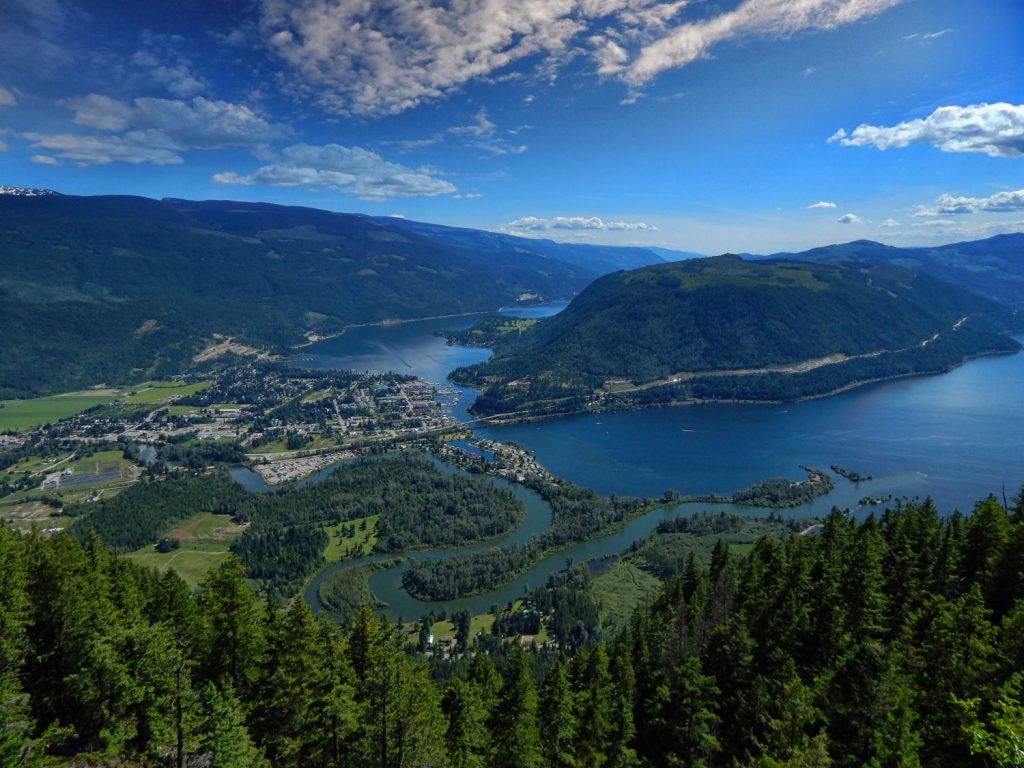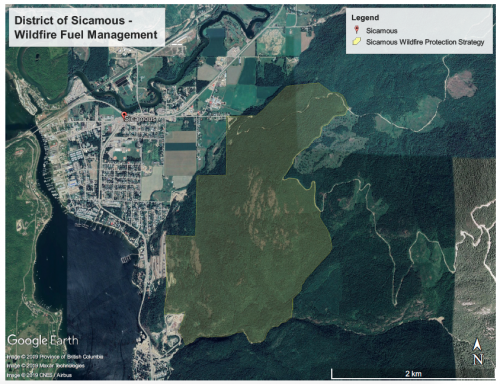
Wildfire risk reduction project to chip debris, use biomass for heat
November 8, 2019
By Forest Enhancement Society of BC
 Photo courtesy District of Sicamous.
Photo courtesy District of Sicamous. A wildfire risk reduction project, valued at almost $1 million, is ready to roll out to provide greater protection from wildfires around the perimeter of Sicamous. The Forest Enhancement Society of B.C. (FESBC) project will protect important infrastructure owned by the District of Sicamous (DOS) like its water reservoir and vital transportation corridors. The DOS will also realize another benefit from the work removing forest fuels in the development of a mountain bike park in the treatment area to allow for greater and safer access for citizens.
“Our community welcomes a large number of tourists each year,” said operations manager for the DOS, Joe McCulloch. “The work we’re doing now will not only help protect our local community and important infrastructure from the threat of wildfire but will also create additional opportunities for people to safely access the land for their recreational pursuits.”
The first area identified for priority treatment will be the community’s eastern boundary, an area with dense second growth Doulas fir, larch, cedar, and hemlock stands that extend from mountain tops to valley bottoms. These forests include high risk wildfire threats.
“We are excited to move forward on this project,” said DOS fire chief, Brett Ogino. “The first treatment will involve commercially thinning the overstory. The second treatment, funded by FESBC, entails thinning the understory by pruning and brushing to remove ladder and ground fuels. The combined treatments will reduce future wildfire intensity and reduce the likelihood of the fire getting into the treetops. If we can keep future fires on the ground, fire fighters will have a better chance of protecting the community. The area becomes increasingly drier in the summers and is a primary access point for thousands of recreational users. We still want people to be able to access these areas safely and enable our fire crews to have safer and easier access in the event of a wildfire.”
The project will also enhance the utilization of forest fibre by chipping the debris and utilizing that biomass for heat and eventually power. Currently, the DOS is in the process of planning and designing a bioenergy system to utilize biomass produced by the work of the project.
“We are looking to set up a state-of-the-art bioenergy heating system using revolutionary wood heating technology,” said McCulloch. “We’ve been in conversations with a B.C. company that manufactures biomass boilers about what we could develop here in Sicamous. The utilization of the biomass for bioenergy conversion will significantly reduce the amount of carbon being released into the atmosphere compared to burning debris piles, thus reducing greenhouse gas emissions. We think utilizing the debris as we ‘clean up’ after ourselves makes this a great project from start to finish.”
The project is an opportunity to collaborate with the Splatsin First Nation who have offered the DOS a letter of support.
“FESBC is keenly interested in funding a successful project in this area,” said Dave Conly, RFP, operations manager with FESBC. “The wildfire hazards are significant and can be drastically reduced through proper fuel management treatments. We are impressed with the DOS’s plan as it shows strong coordination and collaboration between multiple interest groups and agencies to ultimately achieve a number of objectives, with the reduction of wildfire risk in critical areas adjacent to infrastructure being a high priority.
“We have been encouraging the DOS to work closely with the Ministry of Forests, Lands, Natural Resource Operations and Rural Development District Okanagan Shuswap, BC Timber Sales, and BC Wildfire Services to clearly establish the outcomes necessary for a successful project.”
Pam Shumka, resource manager, Okanagan Shuswap Natural Resource District, Ministry of Forests, Lands, Natural Resource and Rural Development agrees. “Reducing the effects from wildfire on our watersheds and our communities is one of the most important things we can do. Our Natural Resource District is very pleased to partner with the DOS, First Nations, and FESBC on this project.”
The DOS team has been grateful for the leadership and guidance of FESBC.
“We’d like to thank FESBC operations manager Dave Conly for his exceptional guidance through this project,” said McCullouch. “The funding FESBC provided has enabled us to seek out partnerships with First Nations, explore opportunities on how we keep the locals and tourists safe, protect infrastructure, and look at setting up a community forest partnership in the future. Without this funding, we would never have had the opportunity to be where we are today, and we truly thank FESBC and the provincial government for their financial support.”

Google Maps image shows visual of wildfire fuel management map.
Print this page